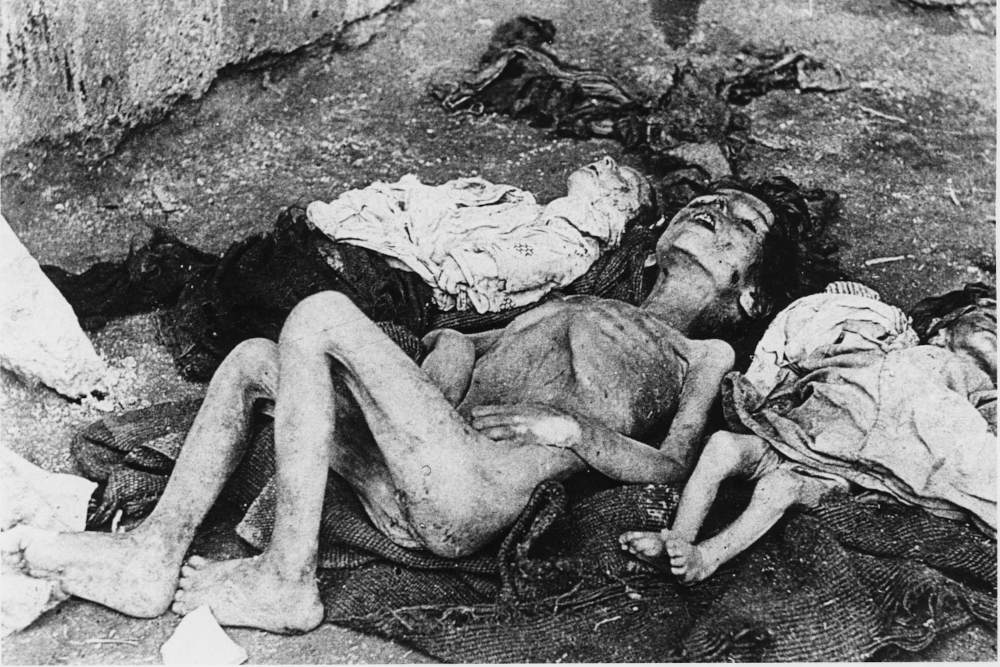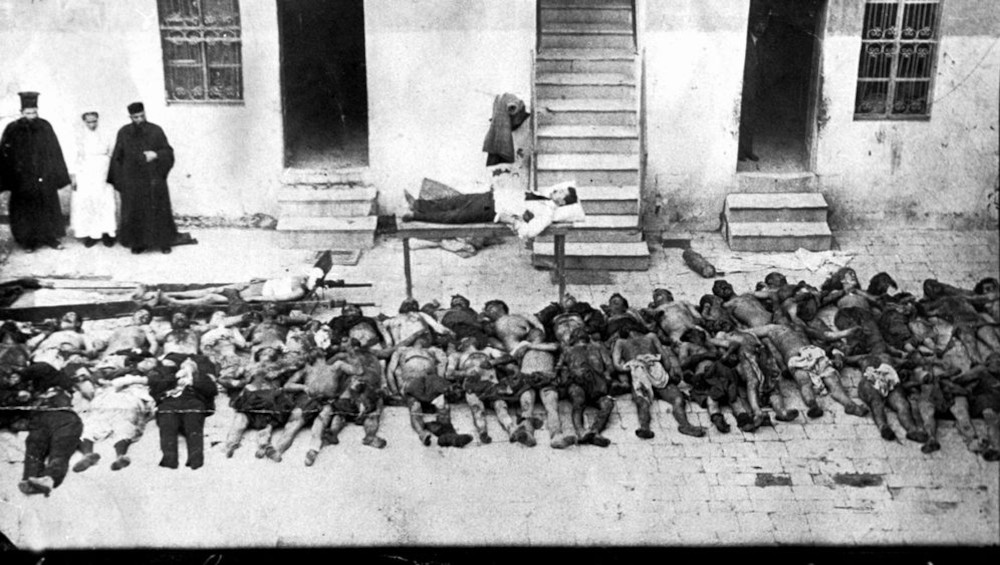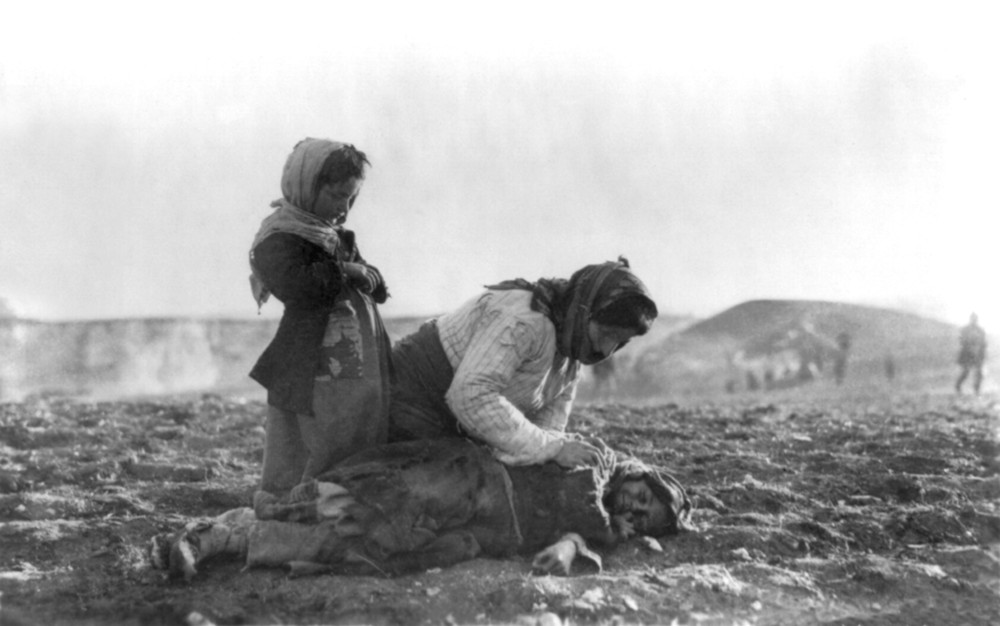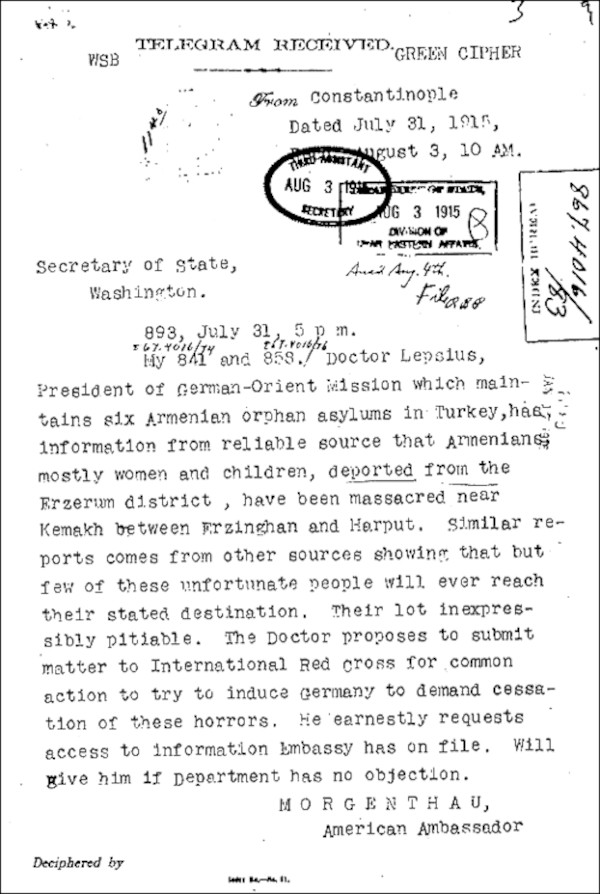
Crucified women, victims of the Armenian Genocide.
Armenian Genocide
The Armenian Genocide took place before the coining of the term genocide. English-language words and phrases used “massacres”, “atrocities”, “annihilation”, “holocaust”, “the murder of a nation”, “race extermination” and “a crime against humanity” to characterize the event.
Raphael Lemkin coined “genocide” in 1943, with the fate of the Armenians in mind; he later explained that: “it happened so many times … It happened to the Armenians, then after the Armenians, Hitler took action.” Relying on the cover of World War I, in 1915 the Young Turk regime ruling the Ottoman Empire embarked upon the state-organized wholesale deportation and mass killing of the Armenian population of Asia Minor. The deliberate murder of 1.5 million Armenians was denounced as a crime against humanity.
Armenia is one of the world's oldest civilizations. Inhabiting the mountainous Caucasus region at the crossroads of Europe and Asia, the people of Armenia have shared a unique language and culture for over 3,000 years.

On April 24, 1915, Turkish officials arrested 250 Armenian leaders and intellectuals in Constantinople. More arrests followed as thousands of Armenian notables were imprisoned, executed or deported. First, the able-bodied men were disarmed, then moved out of their homes and massacred. Thereafter, the women and children marched to death, sold into slavery, forcibly converted to Islam, or raped and killed at will. Turkish officials enforced the deportations ruthlessly. Entire Armenian villages slaughtered and burnt to the ground. In the city of Trebizond, hundreds of women and children drowned in the Black Sea.

“The main executioner was Djevdet Pasha, the brother-in-law of the minister of war, Enver Pasha, who, in February 1915, was made governor of Van. A sadist known throughout Armenia as the “horseshoe of Bashkale” for his favourite pastime of nailing horseshoes to the feet of his victims, Djevet inaugurated his term in office by slaughtering some eight hundred people—mostly old men, women, and children. By April the death toll had risen to ten thousand, and in the following months the population of the Van zone would be systematically exterminated.”
Trebizond (now Trabzon) was the main city in Trebizond Vilayet; Oscar S. Heizer, the American consul at Trebizond, reported: “This plan did not suit Nail Bey … Many of the children were loaded into boats and taken out to sea and thrown overboard”. Hafiz Mehmet, a Turkish deputy serving Trebizond, testified during a 21 December 1918 parliamentary session of the Chamber of Deputies that “the district's governor loaded the Armenians into barges and had them thrown overboard.” The Italian consul of Trebizond in 1915, Giacomo Gorrini, writes: “I saw thousands of innocent women and children placed on boats which were capsized in the Black Sea”. Dadrian places the number of Armenians killed in the Trebizond Vilayet by drowning at 50,000. The Trebizond trials reported Armenians having been drowned in the Black Sea; according to a testimony, women and children were loaded on boats in “Değirmendere” to be drowned in the sea.

Lt. Hasan Maruf of the Ottoman army describes how a population of a village were taken all together and then burned. The Commander of the Third Army Vehib's 12-page affidavit, which was dated 5 December 1918, was presented in the Trebizond (Trabzon) trial series (29 March 1919) included in the Key Indictment, reporting such a mass burning of the population of an entire village near Muş: “The shortest method for disposing of the women and children concentrated in the various camps was to burn them”. Further, it was reported that “Turkish prisoners who had apparently witnessed some of these scenes were horrified and maddened at remembering the sight. They told the Russians that the stench of the burning human flesh permeated the air for many days after”. Genocide scholar Vahakn Dadrian wrote that 80,000 Armenians in 90 villages across the Muş plain were burned in “stables and haylofts”.

Ottoman physicians contributed to the planning and execution of the genocide. The physicians Behaeddin Shakir and Nazım Bey were leading figures in the leadership committee of the Committee of Union and Progress, and both held leadership roles in the Special Organization. Other physicians used their medical expertise to facilitate the killings, including designing methods for poisoning victims and using Armenians as subjects for lethal human experimentation.
Specific medical methods used to kill victims included:
- Morphine overdose: During the Trebizond trial series of the Martial court, from the sittings between 26 March and 17 May 1919, the Trabzons Health Services Inspector Dr. Ziya Fuad wrote in a report that Dr. Saib caused the death of children with the injection of morphine. The information was allegedly provided by two physicians (Drs. Ragib and Vehib), both Dr. Saib's colleagues at Trebizond's Red Crescent hospital, where those atrocities were said to have been committed.
- Toxic gas: Dr. Ziya Fuad and Dr. Adnan, public health services director of Trebizond, submitted affidavits reporting cases in which two school buildings were used to organize children and send them to the mezzanine to kill them with toxic gas equipment.
- Typhoid inoculation: The Ottoman surgeon, Dr. Haydar Cemal wrote "on the order of the Chief Sanitation Office of the Third Army in January 1916, when the spread of typhus was an acute problem, innocent Armenians slated for deportation at Erzincan were inoculated with the blood of typhoid fever patients without rendering that blood 'inactive'". Jeremy Hugh Baron writes: “Individual doctors were directly involved in the massacres, having poisoned infants, killed children and issued false certificates of death from natural causes. Nazim's brother-in-law Dr. Tevfik Rushdu, Inspector-General of Health Services, organized the disposal of Armenian corpses with thousands of kilos of lime over six months; he became foreign secretary from 1925 to 1938”.
While there is no consensus as to how many Armenians lost their lives during the Armenian Genocide, there is general agreement among western historians that over 800,000 Armenians died between 1914 and 1918. Estimates vary between 800,000 and 1,500,000 (per the governments of France, Canada, and other states).